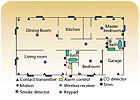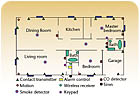ANSWERS BELOW.
- All wireless devices have the same range capabilities.
- True
- False
- Some wireless devices are listed by UL for use in:
- residential applications.
- commercial applications.
- fire systems.
- All of the above
- Which of the following construction materials can block RF signals?
- Wood paneling
- Sheetrock
- Plate glass
- Metal
- All of the above
- Which of the following can affect the operation of a wireless transmitter?
- Distance to receiver
- Construction materials
- EMI
- All of the above
- All wireless systems are fully supervised.
- True
- False
- Wireless transmitters have been integrated with:
- motion detectors.
- glass break detectors.
- smoke detectors.
- water detectors.
- All of the above
- All wireless systems operate on the same frequency.
- True
- False
- Wireless systems operate un-der the regulations of the FCC.
- True
- False
- The power ratio between a meaningful radio signal and the background noise is referred to as the:
- reflected signal strength.
- output power.
- operating frequency.
- signal-to-noise ratio.
- All of the above
- Wireless devices can be added to any hard-wired control.
- True
- False
- What frequency do wireless systems operate on?
- 315 MHZ
- 345 MHZ
- 900 MHZ
- Any of the above
- None of the above
- The batteries in all wireless transmitters will last the same amount of time.
- True
- False
- You can extend the coverage of some wireless systems by adding wireless repeaters.
- True
- False
- Each supervised transmitter must have a unique identifier.
- True
- False
- Wireless systems can be armed/disarmed by using a:
- key switch.
- wired keypad.
- wireless keypad.
- Any of the above

What’s Wrong with This?
Wally `Larman installed a wireless security system for a residential account consisting of 14 door/ window transmitters, four motion transmitters, five smoke detector transmitters, and five CO detectors, as shown in this diagram. Wally carefully tested every device and determined that the system was operating properly. A few months later, his customer called and told him that the keypad was displaying a trouble for the master bathroom window transmitter. Wally checked the system and found that the transmitter was defective, so he replaced it and tested the system. Everything seemed OK, but a few months later, his customer again called with the same problem. Can you see what Wally did wrong?5 Minute Tech Quiz Answers
- b
- d – Some wireless systems have been listed for use in both residential and commercial burglary as well as fire applications.
- d – While the propagation of the radio waves will depend upon the frequency of the system, metal surfaces will reflect radio waves, thus blocking them.
- d
- b – Not all systems supervise every transmitter for battery condition, functionality and status of the device (open/closed).
- e
- b
- a
- d
- a – Depending on the control used, you can either add a wireless interface, or if the control does not support a direct interface, you can add a wireless receiver that has multiple relay outputs that can be connected to traditional zones of the control.
- d – The frequency used depends upon the manufacturer selected.
- b
- a
- a
- d



